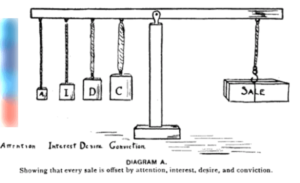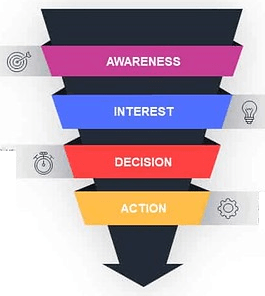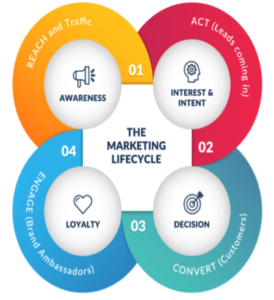Imagine
The “sale funnel” is century-plus old.
Whoa!
It was first discovered by E.ST.Elmo Lewis in 1898.
The sale funnel squeezes buyers through a funnel for them to make a sale.
Unfortunately, It can’t keep pace with the modern iffy online buyers.
Modern buyers have great control over what they buy. They are well informed. They have many choices. They are aware of your competitors.
Well?
The sale funnel got remodeled to lifecycle marketing. Lifecycle marketing is sensitive to modern buyers.
In this post, we will look at why the sales funnel isn’t working? Try to understand the modern buyer. Take a look at the modernized lifecycle marketing, its phases and why it works for online buyers.
Sounds good?
Let’s get started.
Sale Funnel Marketing-Brief Background
Before Lifecycle marketing there was “sales funnel”
Let’s dig into their brief history.
The marketing stages also known as AIDA Model-Awareness,Interest, Desire Action. Was developed by E.ST.Elmo Lewis back in 1898.
Here is the initial model

In 1904 the model was on a chart. The chart showed the interrelation between one stage to the other.
Here is how it looked in January 1904 as per the Salesmanship magazine.

Later in 1924, William Townsend developed the idea into a funnel. He wrote about it in his book Bond Salesmanship.
Here is the century-old funnel that marketers are using.

Why Sales Funnel isn’t Working
The Sale funnel is dead. It’s not for the digital modern age.
In the 19th Century, selling products and services was easy. What the sales rep needed was to explain the benefits of products and services over the others.
Using guided tools you could move leads to be customers through the “Sales Funnel” without a hitch.
The AIDA model shaped the buyer’s journey for many decades.But now the “Sales Funnel” is obsolete.
- It can’t predict anything about the buyer
- It can’t tell if the buyer will make a sale
- It’s rigid to fit the modern buyer
- It doesn’t blend with “soft skill” works with “hard skills” only.
Understanding the Modern Buyer
The modern buyer is different.
The Internet has changed everything. Prospects can access information right away on their mobile phones.
Nowadays customers are more or less 60% ready through the buyer’s journey. Even before they contact the sales team. They already have a good idea of what they are looking for.
Your job isn’t to tell them what you offer. But to help them find solutions to their headache. For instance:
- Help them save time.
- Guide them save costs and make more money
- Assist them to reduce stress
Buyers are now involving more decision-makers before they buy. Up to seven
Prospects are more aware of the marketing techniques that you are using.
Nowadays customers prefer products customized.To fit their unique needs.
Buyers enter and exit through the sale funnel stages at any time. Some contact you with a question. Then exit for several months and reappear ready to buy.
Others contact you while they are negotiating with a competitor.
Buyers are now very unpredictable for the “Sales Funnel” to detect.
So what is the solution
Lifecycle Marketing Model
Lifecycle marketing refers to all plans that businesses use. To attract leads, convert, and keep them.
The strategy looks at engaging customers throughout the buying journey.
It acknowledges that the clients are always at a different level of the journey. Lifecycle marketing accepts that clients can either go up or down the funnel. Thus it engages clients in a cycle.
The diagram below shows the lifecycle marketing model.

Why is Lifecycle Marketing Different?
Lifecycle marketing is an improved version of the “Sale Funnel”.
It best aligns with content marketing and the unpredictable new online buyers.
Lifecycle marketing focuses a lot on “soft skills” that get ignored. They include kindness, empathy, trust, improving customer care. And creating a lifelong customer relationship.
The old “Sale funnel” focused on “hard skills“. Like aggressiveness, assertiveness, and being pushy. The hard skills are quantifiable and most companies still use them. This is because they show you are working. They are as angry as a gorilla.
A study of failed CEOs shows that their business sunk. Because they practiced hard skills ONLY no soft skills.
The “Sales Funnel” focused on squeezing prospects narrow through the funnel.It ignores the freedom of choice that customers have. Modern buyers get influenced by the internet. Before they buy they:
- Engage in online forums
- Check on third party reviews
- Engage social media
- They search for information hubs
- Have already started online conversations through chats or email
All these factors make buyers unpredictable. They jump in and out of the sales funnel stages.
This is what lifecycle marketing helps to address. It deals with clients in cycles and engages them at different levels.
Imagine
Your buyer shows interest at the intent stage. Ready to buy. But finds another competitor.
The competitors give more information about the product.
Whoops!
The customer jumps back again to the top of the funnel. Do you think you have lost him? No. Using lifecycle marketing you can use a retargeting technique to win them back.
The truth is the modern buyers are different. They are in full control and the old “Sale Funnel” does not capture that.
Redefined lifecycle marketing is the answer.
Lifecycle Marketing Phases

Wondering how to get started with Lifecycle marketing?
Here are the four key stages.
Ready?
Let’s get started.
Awareness
This is when the potential lead hears about you.
They are eager to find more information that will help solve their problems.
Where is your lead at the cycle?
They need information. They are looking for value-focused information. It’s very inappropriate to start a sales pitch at this point.
What appeals to prospects at this stage?
High-quality content that builds authority. The content should establish a great level of trust.You need to empathize with your readers.
Find what is giving them headache.Give actionable solutions to their problems.
What’s the best content at this stage?
At this stage of the lifecycle marketing focus on.
- High-quality SEO blogs
- Original case studies
- Round-up research
- Creative stories
- Entertaining real-life experience
- Books published by brand leaders
- E-books and lead magnets
- Social media content both video and copy
As you develop these content ask yourself.What’s new that you are contributing to the market?
Interest and Intent
Interest and intent are two separate stages in the sales funnel.
The funny part is that. Smart online buyers can move from desire to interest uninterrupted.
Once the leads are warm. Starting a conversation is very easy. This is as a result of the efforts you had at the awareness stage.
Start the conversation
According to GeoMarketing. Customers exchange over 2 billion business messages on Facebook only every single month.
So use email, live chats, Messenger, skype calls, direct mail. Or WhatsApp to usher a personalized relationship.
Aim to engage with the prospect one on one. It helps you create a rapport that can lead to a sale. Here is where the soft skills come to play.
Be human, understanding and empathize with the prospect.
Where is your lead at the cycle?
They show interest in your brand, products or services with the intent potential to buy.
What appeals to the prospect at this stage?
Conversational marketing. How fast you respond to live Chats and calls. Quality customer care services.
What is the best content at this stage?
You want to entice the customers to take the buying action. Then you have to do the following.
- Engage in conversational marketing
- Use live chats, messenger bots.
- Book calls with the prospects.
- Use lead magnets and e-books
- Make it easy to contact your team.
- Have clear CTAs and easy contact forms
- Start on list building-we recommend email marketing
- Create webinars
- Start retargeting campaigns
Decision
Also known as the action stage. Here you want a sale.
If the other lifecycle marketing stages have worked well. You have built authority and filled the information needs at the awareness stage.
You have answered the right questions in your conversations. You have built enough trust. Your products/services are strong. This stage will pay off.
Unfortunately, you can screw up at this stage. If you don’t take the right steps.
You can either miss or have the sale delayed. With unpredictable online buyers, anything can happen. They can either move forward or move backward through lifecycle marketing.
Where is the lead at the cycle?
Ready to buy.
What appeals to the prospect at this stage?
Product samples, prices, and quotes. Good reviews from happy customers.The customer care experience.
What is the best content at this stage?
For you not to muddle at this stage. You need to:
- Engage in conversational marketing
- Do follow-up and answer customer questions
- Have positive reviews on major third party sites
- Show product demo that makes sense to your brand
- Offer discounts and coupons
- Make the payment option easy
According to a study by Lead Connect. 78% of buyers prefer brands that respond to their questions.Then respond to questions.
Loyalty
The loyalty sage doesn’t exist in “Sale Funnel”
lifecycle marketing encourages you to keep customers on the loop even after they buy.
Lifecycle marketing promotes a life long relationship with clients. Loyalty is crucial to online buyers. It makes your brand stand out long after the sale.
Provide consistent value. Use the channels you have already created- emails, live chats to share your content.
Where is your lead at this stage?
Your customers get delighted and satisfied. They even speak well of you
What appeals to prospects at this stage?
Great products and friendly follow-ups, Addressing any dissatisfaction. Incredible customer service.
What is the best content at this stage?
For you to keep customers on the loop. You have to do the following.
- Do regular follow-up
- Send thank you messages
- Email them on new content updates
- Share new products
- Start a referral program
- Combine incredible services and great products.
Why Lifecycle Marketing Works for Online Buyers
Why Lifecycle Marketing Works for Online Buyers
In short, the century-old “Sale Funnel” isn’t working.The ever-changing trends of online buyers makes it hard.
Thus the Lifecycle marketing comes in place to bridge the gaps.
Lifecycle marketing is on the same wavelength as the online buyer’s journey. It aligns with content marketing and guides you on what to give at different stages. All through keeping the customer on the loop.
The shift from “Sale Funnel” to lifecycle marketing is easier said than done. But it’s the best way to serve customers. Companies that provide value at each stage will rise above others.
It will make loyal customers who will buy and refer others to buy from your brand.
Creating a never-ending cycle.
Over to You
Now do it. Make your content shine and capture leads on each stage of lifecycle marketing. Contact us today to get started with content marketing.
We will help you develop the right content to knuckle down your leads.

